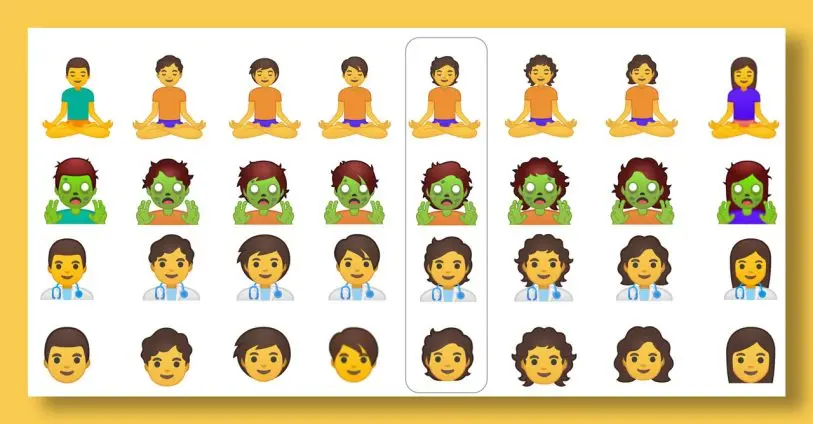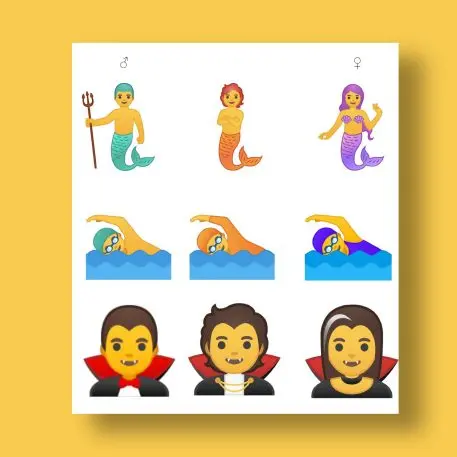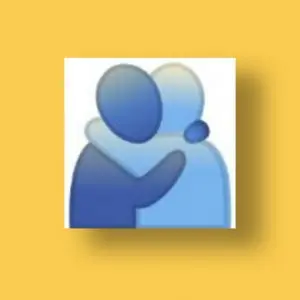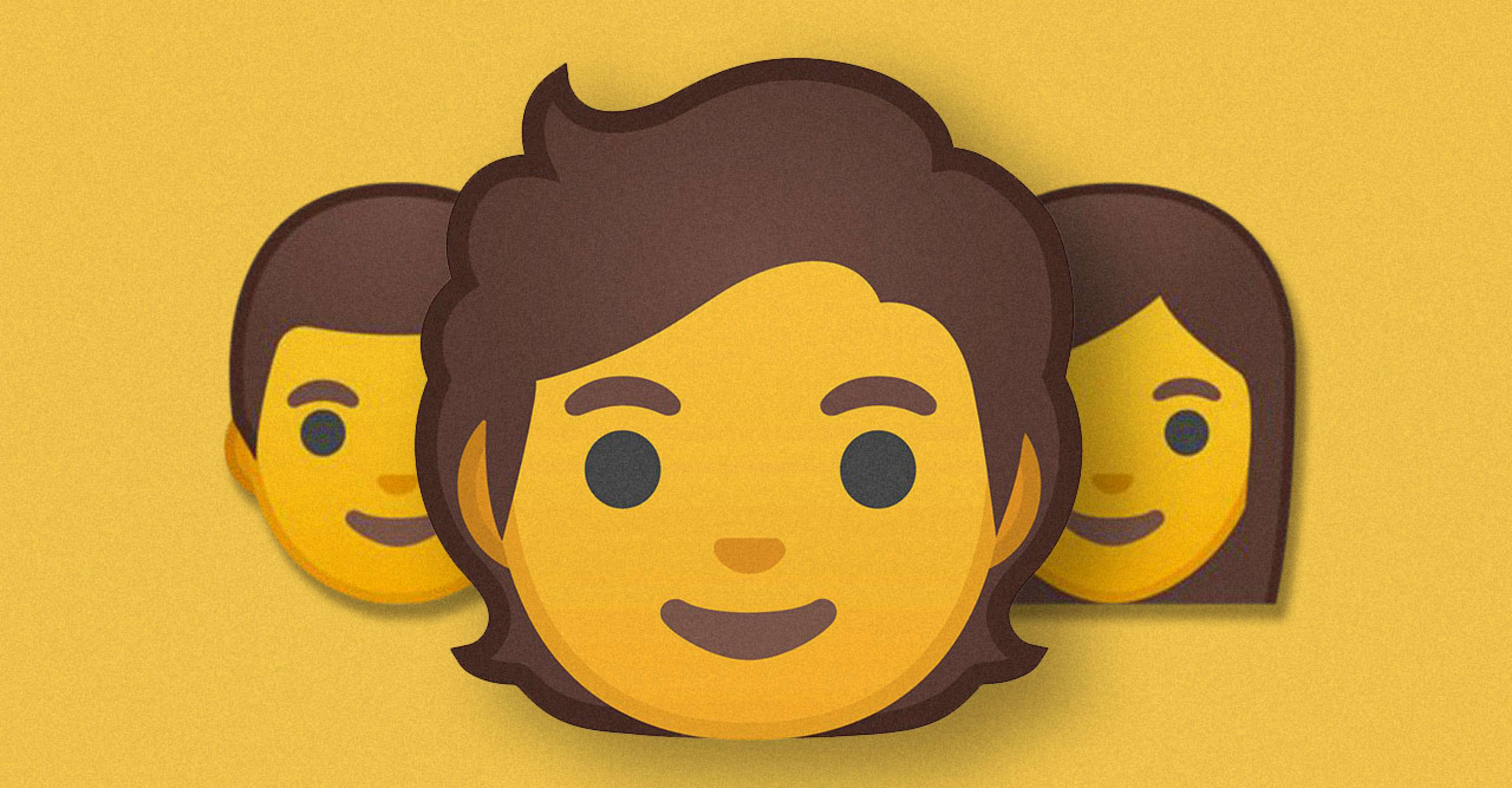In 1999, the Japanese wireless communications company NTT Docomo released 176 pictures for people to quickly, efficiently, and emotively communicate on the tiny screens of their phones. Twenty years later, and we now have over 3,000 emoji and counting. On the one hand, emoji are getting more inclusive. They finally feature same sex parents, female scientists, and people in every skin tone other than Simpsons yellow. On the other, as these icons become more inclusive, each becomes less universal.
Jennifer Daniel, designer at Google, thinks about this deep irony at the heart of visual language all the time. She traces it back to the age-old problem with the male bathroom symbol. “That person could be man, woman, anyone,” she says. “But they had to add a little detail, that dress, and suddenly that person symbol doesn’t mean person anymore; it means man. And that culture means a man-centered culture.”
While Daniel can’t fix our bathroom signage, as the director of Android emojis, she can fix another problem: The lack of gender-neutral symbols in texting. She can give us the zombies, merpeople, children, weightlifters that are neither male nor female. “We’re not calling this the non-binary character, the third gender, or an asexual emoji–and not gender neutral. Gender neutral is what you call pants,” says Daniel. “But you can create something that feels more inclusive.”
Google is launching 53 updated, gender ambiguous emoji as part of a beta release for Pixel smartphones this week (they’ll come to all Android Q phones later this year). Whether Google calls them “non-binary” or not, they have been designed to live between the existing male and female emoji and recognize gender as a spectrum. Given that Google collaborates with many of its rivals on emoji, it’s likely that Apple and others will release their takes on genderless emoji later this year.
[Image: Google]
The complex process of designing emoji for everyone
Daniel sits on the Unicode consortium–the organization that sets core emoji standards, including signifiers like gender and other details, that designers at Apple, Google, and other companies then follow to create their emoji. Last year, she pointed out that there were 64 emoji that, according to Unicode’s standards, were never meant to signify gender. In fact, 11 don’t have a Unicode-defined signifier for male or female at all–like baby, kiss, fencing person, and snowboarder. As for the remaining 53, they could be male, female, or neither.
Yet Apple, Microsoft, Samsung, and, yes, Google, have often assigned genders with their designs for these emoji. It’s why every construction worker across major operating systems is, by default, is a man. Unicode’s standards dictated a construction “person,” but tech companies decided to design them as construction men (and add women as a secondary option).
Of course, this practice reinforces stereotypes, but it can also just be annoying at times. When you text from iOS to Android to Facebook Messenger, you may unintentionally gender swap your emoji. Google depicts a person in a sauna as female. WhatsApp and iOS show them as male. The same gender swaps happen with climbers, handball players, elves, superheroes and villains, and merpeople.

In response, Google decided to be the first company to fill this emoji space between men and women symbols, and to acknowledge gender as something that was fluid rather than binary. “It’s like we’re all at the pool and it’s like the water is cold. Some people want to go swimming, but we’ll wait for someone to swim first,” says Daniel. “We just dove in first.”

The design team went through many drafts to develop their version of a person who is neither necessarily a man or woman.
The team’s work-in-progress designs, which they shared with us, are illuminating. You can tell they were playing a lot with the right haircut, finding the version that would be read as open-ended. They toyed with length, spiky, forward combed bangs, and curls. Ultimately, they opted for hair that’s parted, with casual curls and a bit of length in the back. In some cases, they changed the outfit to support a more open gender interpretation. The vampire has a chain, rather than a bowtie or necklace. The merperson has an orange tail, and they are crossing their arms where pecs or a seashell bra would otherwise be.

Of course, the Google team was still very much playing in the murky waters of stereotypes, and cultural norms, for this work. “I don’t believe there is a way of getting it right, I’ll put it that way. There’s no singular way of getting it right,” says Daniel.
“Gender is complicated,” she continues later. “It is an impossible task to communicate gender in a single image. It’s a construct. It lives dynamically on a spectrum. I personally don’t believe there is one visual design solution at all, but I do believe to avoid it is the wrong approach here. We can’t avoid race, gender, any other number of things in culture and class. You have to stare it in the face in order to understand it. That’s what we’re trying to do–to [find] the signifiers that make something feel either male or female, or both male and female.”
Emoji reflect our society back at us, and tech companies have the power to shape it
In any case, gender-fluid emoji could have very strong design repercussions for everyone who is messaging. Apple’s iOS keyboard currently shows male or female options for each emoji. Android’s picks a mix of men and women. In other words, Apple offers choice but fills your keyboard with options. Android’s display is cleaner, but at the cost of often making a wrong gender guess for you. Gender inclusive emoji could mean fewer, more universal emoji at your fingertips because when there’s only one version of each emoji you need, you can fit more emoji in your view. And if you ever wanted to get more specific, you just long press to pull up other gender-specific options.
That’s how it will work on Android, at least. Daniel is confident that other companies will adopt gender-inclusive emoji, but until they do, any gender-inclusive emoji you send from Android will be misinterpreted as male or female on other platforms. Such is the nature of emoji. A lot can be lost in translation as people share them from one corporation-controlled platform to another.

Going forward, however, Google would like to see all of its new emoji drift away from specificity of gender, race, and more. Daniel is lobbying for a return to amorphous figures–something more akin to the original one-size-fits-all bathroom symbol.
This plan gets back to the problem of what happens when you add increasing amounts of emoji. Each individual emoji variation taken in the context of itself is a great win for inclusion. But taken in aggregate, we’ve ended up in an uncanny valley of representation, where the catch-all power of iconography no longer works because there are too many icons–and yet, there can never be enough specific icons to truly represent everyone and everything in a literal sense. Creative choices and oversights–like the controversial hardshell taco emoji and the lack of a trans pride flag–can feel like insults in their own way.

So what will Google’s emoji of the future look like? Daniel points to “hug,” an emoji that is under consideration with Unicode but won’t be out until 2020 at the earliest. “We designed two people hugging, kept them in shadow, ambiguous of gender and race. When you don’t have gender or race, you don’t have to develop 71 variants,” says Daniel. “This proposal is an example of how we’re thinking of emoji design right now, to take as much detail as possible out of it. That hug can be a bear hug. It can be an ‘I’m sorry to hear that hug.’ It can be an ‘I’m going on a plane and will see you when I get off,’ hug.”
For all the emoji we have today, the most popularly used are still all of the smiley faces, according to Daniel. They’re just emotions, spelled out through the most minimal details of a human face. We seem to crave universality in our communicative practices. We’re happy to simply be people. And so, at least in theory, Google’s new gender-inclusive emoji are a step in that universal direction.
“For a big company [like Google] that’s engineering driven, there’s usually a perceived right way and wrong way of doing things. But when you’re making something like this, there really isn’t a right or wrong way,” says Daniel, who pauses a moment before letting out a cathartic laugh. “I really hope it’s not wrong. I don’t want it to be wrong.”
Recognize your brand’s excellence by applying to this year’s Brands That Matter Awards before the early-rate deadline, May 3.
